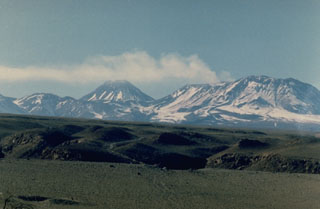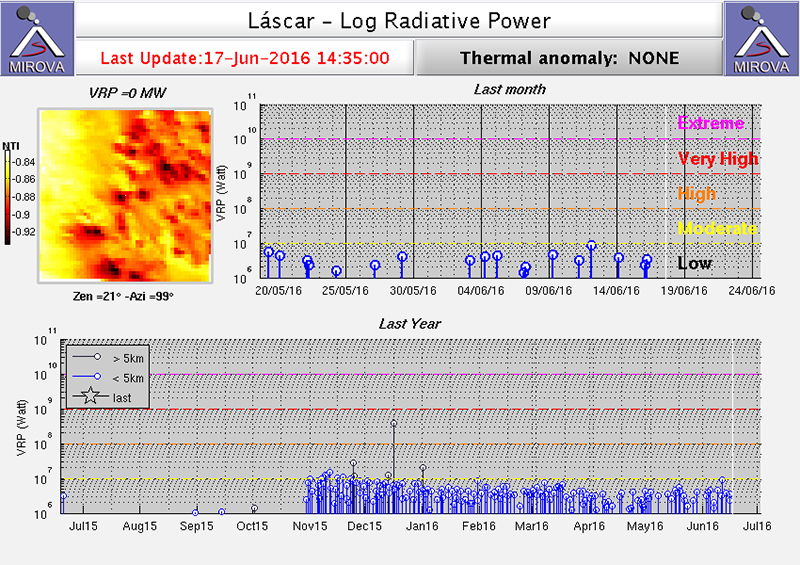Report on Lascar (Chile) — July 2016
Bulletin of the Global Volcanism Network, vol. 41, no. 7 (July 2016)
Managing Editor: Edward Venzke.
Edited by A. Elizabeth Crafford.
Lascar (Chile) Ash plume on 30 October 2015 rises 2,500 m high; variable seismicity and persistent thermal anomaly afterwards
Please cite this report as:
Global Volcanism Program, 2016. Report on Lascar (Chile) (Crafford, A.E., and Venzke, E., eds.). Bulletin of the Global Volcanism Network, 41:7. Smithsonian Institution. https://doi.org/10.5479/si.GVP.BGVN201607-355100
Lascar
Chile
23.37°S, 67.73°W; summit elev. 5592 m
All times are local (unless otherwise noted)
Lascar experienced one significant volcanic event between January 2014 and June 2016, a 2,500-m-high ash plume on 30 October 2015, according to reports issued by Chile's SERNAGEOMIN-OVDAS (Servicio Nacional de Geología y Minería, Observatorio Volcanológico de los Andes del Sur). Seismicity, deformation, SO2 emissions, and thermal anomalies were all monitored by the agency during this time. A thermal anomaly persisted following the 30 October explosion through at least 16 June 2016.
The volcano had a maximum of eight volcano-tectonic (VT) seismic events per month (in September 2014 and October 2015) recorded between January 2014 and June 2016, and usually only 2-4 events. The local magnitude ranged from 0.5 to 2.5. The distance from the crater was also variable, ranging from inside the crater (June and July 2014), to as far as 15 km NE (September 2014). Seismic events were located in many different directions from the central crater. The depth of the events ranged from 0.6 km (March 2014) to 9 km (February 2016).
The long-period (LP) seismic events showed a more consistent trend. From March through August 2014, there were fewer than 6 events recorded each month. In September, the number-of-events increased to 13, and then beginning in November 2014, over 100 LP events were recorded monthly through July 2015. The largest number was in May 2015 with 209 events. Numbers decreased to 54 in October 2015, and then dropped back into the single digits in November 2015 (after the ash event on 30 October). Eight or fewer LP events occurred monthly during the first half of 2016. All LP events had local magnitudes (ML) less than 1.3, most had values less than 1.0.
Outgassing was regularly observed, with the highest monthly plume heights reported ranging from 600 to 2,000 m between March 2014 and September 2015. At 0932 local time on 30 October 2015, the webcam captured an ash emission rising 2,500 m above the summit and drifting NE over the volcanic complex. Based on this activity, the Alert Level was raised to Yellow (the second on a four-color scale). The Chilean Oficina Nacional de Emergencia Ministerio del Interior (ONEMI) declared a Yellow Alert for the municipality of San Pedro de Atacama, located 70 km NW of the volcano. The Buenos Aires VAAC also identified a short plume near the summit in satellite imagery which dispersed quickly. The Alert Level was lowered back to Green on 16 November 2015. Water-vapor rich emissions to 2,000 m were reported from November 2015 through June 2016, with no additional ash emissions observed.
Incandescence at the summit was observed in March and April 2014, and November 2015. The only SO2 anomaly occurred on 30 October 2015 during the ash-plume event. It was recorded by the OMI instrument via satellite at 49 kilotons. Otherwise SO2 levels at the volcano were within the normal range, with minor fluctuations.
Small thermal anomalies were intermittent prior to late October 2015, at which time the MIROVA data shows infrared (IR) signatures at the summit consistently, continuing through at least 16 June 2016 (figure 45), with the intensity and frequency slowly decreasing. No MODVOLC anomalies were recorded during this period.
Geological Summary. Láscar is the most active volcano of the northern Chilean Andes. The andesitic-to-dacitic stratovolcano contains six overlapping summit craters. Prominent lava flows descend its NW flanks. An older, higher stratovolcano 5 km E, Volcán Aguas Calientes, displays a well-developed summit crater and a probable Holocene lava flow near its summit (de Silva and Francis, 1991). Láscar consists of two major edifices; activity began at the eastern volcano and then shifted to the western cone. The largest eruption took place about 26,500 years ago, and following the eruption of the Tumbres scoria flow about 9000 years ago, activity shifted back to the eastern edifice, where three overlapping craters were formed. Frequent small-to-moderate explosive eruptions have been recorded since the mid-19th century, along with periodic larger eruptions that produced ashfall hundreds of kilometers away. The largest historical eruption took place in 1993, producing pyroclastic flows to 8.5 km NW of the summit and ashfall in Buenos Aires.
Information Contacts: Servicio Nacional de Geología y Minería (SERNAGEOMIN), Avda Sta María No. 0104, Santiago, Chile (URL: http://www.sernageomin.cl/volcanes.php); Observatorio Volcanológico de los Andes del Sur (OVDAS), Temuco (URL: http://www.sernageomin.cl/volcan-observatorio.php); Oficina Nacional de Emergencia Ministerio del Interior (ONEMI) (URL: http://www.onemi.cl/); Buenos Aires Volcanic Ash Advisory Center (VAAC), Servicio Meteorológico Nacional-Fuerza Aérea Argentina, 25 de mayo 658, Buenos Aires, Argentina (URL: http://www.smn.gov.ar/vaac/buenosaires/productos.php); MIROVA, a collaborative project between the Universities of Turin and Florence (Italy) supported by the Centre for Volcanic Risk of the Italian Civil Protection Department (URL: http://www.mirovaweb.it/)


